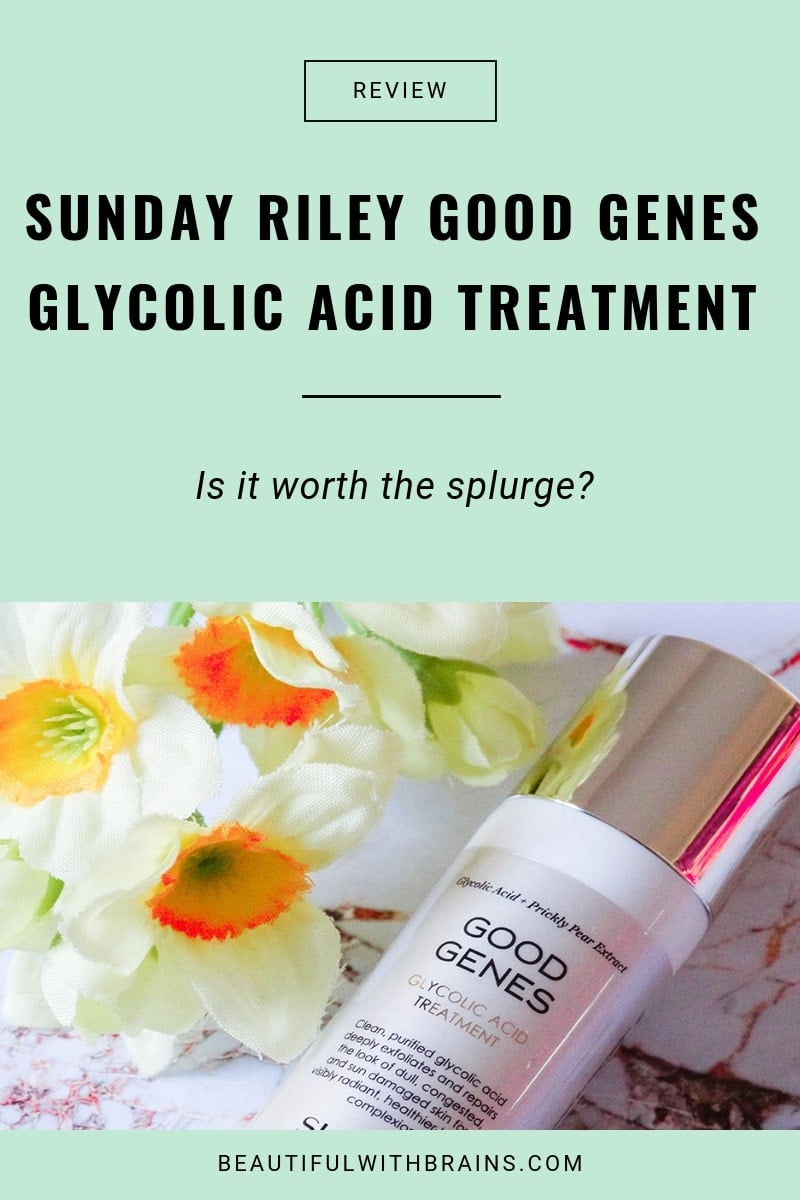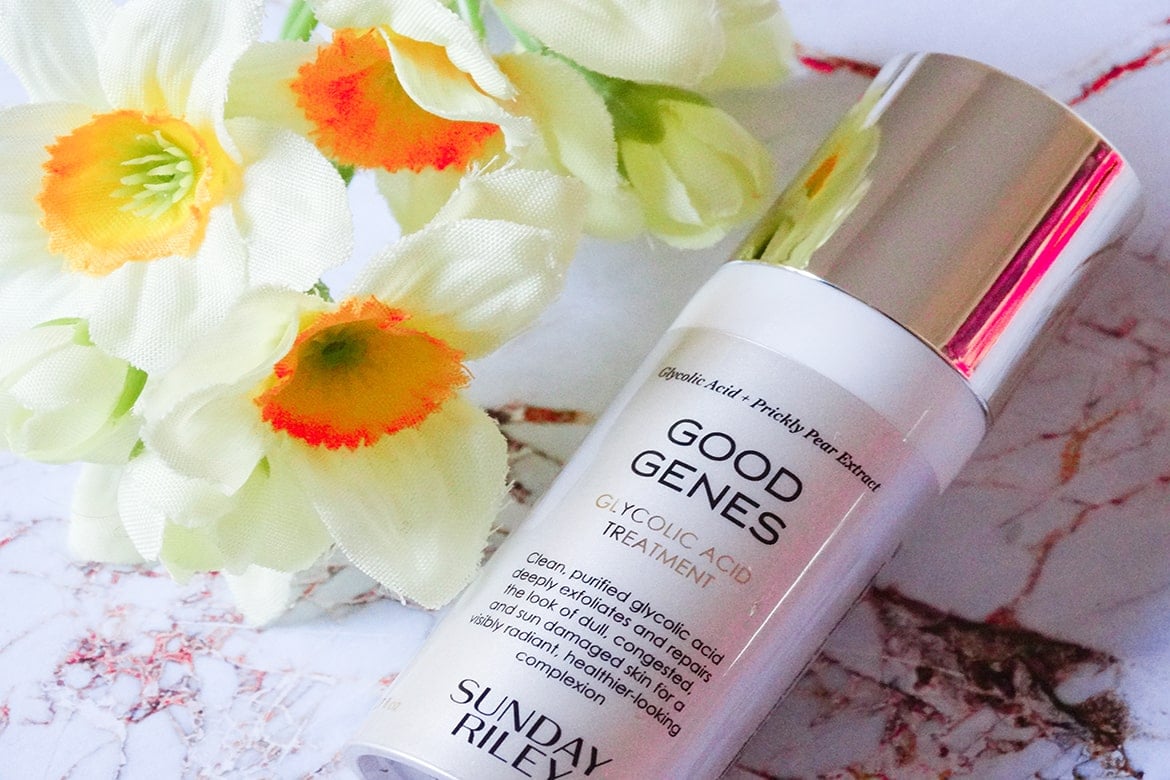
My heart broke when Sunday Riley reformulated Good Genes with glycolic acid instead of lactic acid.
I totally get it why she had to do it. A new EU law dictates that brands can’t sell lactic acid treatments that have a 10% concentration or a pH lower than 5.
Thanks EU! Don’t you have better things to do than screwing up with our skincare? I know you’re trying to protect consumers, but no one has ever died from using Good Genes.
Plus, there are so few exfoliants suitable for sensitive skin. With this move, a lot of people with sensitive skin could switch to something that’s more irritating for their skin. Like, you know, glycolic acid…
I can’t in good conscience recommend the new glycolic version of Sunday Riley Good Genes to anyone with sensitive skin anymore. 🙁
But what if you don’t have sensitive skin? If your skin can tolerate glycolic acid, Sunday Riley Good Genes Glycolic Acid Treatment is still a great buy:
P.S. Yes, that in the picture above is a sample size. I wasn’t sure I was gonna like the new version of Good Genes so I treated myself (read: bought with my own money) to a Sunday Riley holiday set with mini sizes of the brand’s bestsellers to find out.
- What’s In Sunday Riley Good Genes Glycolic Acid Treatment?
- Texture
- Fragrance
- How To Use It
- Performance & Personal Opinion
- Who Is This For?
- Who Is This NOT For?
- Packaging
- Does Sunday Riley Good Genes Glycolic Acid Treatment Live Up To Its Claims?
- Price & Availability
- Do You Need It?
- Dupes & Alternatives
What’s In Sunday Riley Good Genes Glycolic Acid Treatment?
GLYCOLIC ACID TO EXFOLIATE SKIN
The old Sunday Riley Good Genes used 7% lactic acid at a pH of 3. The new Sunday Riley Good Genes uses 7% glycolic acid + a lactic acid salt at 3% and a pH of 3.5. What’s the difference?
Glycolic acid and lactic acid are both members of the Alpha Hydroxy Acids (AHAs) family, a group of exfoliants that dissolves the “glue” that holds skin cells together so they can slough off.
Glycolic acid has a smaller size than lactic acid. This makes it more effective (you’ll see results sooner) but also more irritating. That’s why I can’t recommend it for sensitive skin.
Glycolic acid and lactic acid have another thing in common: they have water-binding properties that deeply hydrate skin.
In theory, glycolic acid goes even further: this acid is famous for boosting collagen production. The catch? It does it at 10%+ concentrations.
Sunday Riley Good Genes Glycolic Acid Treatment has 7% glycolic acid so don’t expect it to do too much for antiaging. Here, it only exfoliates skin, smoothens out its texture, fades away dark spots, and gives the complexion a beautiful glow. Not shabby, is it?
FYI, if you have oily skin or acne, salicylic acid is a much better exfoliant for you.
Related: Glycolic Acid Vs Lactic Acid: Which One Should You Choose?
SQUALANE TO MOISTURISE SKIN
Everyone’s into squalane at the moment – Sunday Riley Good Genes Glycolic Acid Treatment uses it, too.
What’s so special about it? For starters, it’s so similar to human sebum (your skin’s natural moisturiser) so it sinks in super quickly.
That makes it super moisturizing too. Squalane strengthens the skin’s protective barrier, moisturises skin and keeps it soft and smooth for hours.
The best part? It’s safe for everyone. It doesn’t cause irritations or give you breakouts. Heck, even people with fungal acne can use it without risking another flareup.
Related: Everything You Need To Know About Squalane In Skincare

DIMETHICONE TO FILL IN FINE LINES AND WRINKLES
Yep, the base of Sunday Riley Good Genes Glycolic Acid Treatment is Dimethicone, a famous silicone many people love to hate. They say it clogs pores, suffocates skin and has zero benefits for the skin. I wouldn’t be so drastic…
It’s true Dimethicone has no antioxidants or soothing properties. But it makes the texture easier to spread, fillS in fine lines and large pores so they look smaller, and creates a barrier on the skin that keeps moisture in.
By the way, this barrier is breathable. Silicones have a particular molecular structure with wide gaps between each molecule. Skin can perspire through these gaps.
While we’re busting skincare myths, Dimethicone itself doesn’t clog pores. It’s when you use it together with comedogenic ingredients that breakouts happen.
Related: Are Silicones Bad For Skin?
Struggling to put together a skincare routine that banishes dryness and makes your skin supple and dewy? Download your FREE “Best Skincare Routine For Dry Skin” to get started (it features product recommendations + right application order):
Texture
Lightweight, lotion-like texture that sinks in immediately on my dry skin.
Fragrance
It’s fragrance-free.
How To Use It
Every other night, after cleansing. Alternate it with retinol.
Performance & Personal Opinion
If you’re expecting a change in pore size or blackhead removal, you’ll be disappointed. That’s a job for salicylic acid, not glycolic acid.
But if you’ve got dry skin with small pores and no blackheads, you’re in for a treat. Already the morning after using Sunday Riley Good Genes Glycolic Acid Treatment, my skin was already brighter. It had a lovely glow to it.
My skin also got softer. Without all those dead cells on my skin, the whole surface was smoother and softer to the touch.
All in all, Sunday Riley Good Genes Glycolic Acid Treatment did exactly what I expected it to do: it exfoliated the surface of my skin so that it looks smoother and more awake. Good job!
Who Is This For?
- Dry skin
- Sun-damaged skin
Who Is This NOT For?
- Oily, acne-prone skin
- Sensitive skin
Packaging
It comes in a sleek bottle with a practical pump applicator.
Does Sunday Riley Good Genes Glycolic Acid Treatment Live Up To Its Claims?
| CLAIM | TRUE? |
|---|---|
| Clean, purified glycolic acid deeply exfoliates and repairs the look of dull, congested, and sun damaged skin for a visibly radiant, healthier-looking complexion. | It doesn’t help congested skin, but everything else is true. |
| Good Genes Glycolic penetrates the surface of the skin with tiny glycolic acid molecules, sinking deeper into the skin than other forms of AHA, to break apart pore-clogging debris and repair the look of sun-damaged, congested, wrinkled, or dull skin. | Mostly true. Glycolic acid is the smallest member of the AHAs family, so it does penetrate deeper into the skin for better results. But it can’t penetrate pores so it can’t break apart pore-clogging debris. That’s a job for salicylic acid. |
| With just one use, instant radiance and skin clarity are visibly boosted. | Yes, it does give skin a lovely glow. But every exfoliant does this. |
Price & Availability
£85.00 at Cult Beauty, Net-A-Porter and SpaceNK
Do You Need It?
If you have dry, sun-damaged skin, this is a great option to consider.
Dupes & Alternatives
- Cosrx AHA 7 Whitehead Power Liquid ($18.00)
- The Inkey List Glycolic Acid Toner (£6.99)
- The Ordinary Glycolic Acid 7% Toning Solution (£6.75)
Ingredients
Water/ Aqua/ Eau, Dimethicone, Glycolic Acid, Squalane, Caprylyl Caprylate/Caprate, PPG-12/SMDI Copolymer, Potassium Lactate, Cetearyl Alcohol, Propanediol, Stearic Acid, Glycerin, PPG-24-Glycereth-24, Bis-Stearyl Dimethicone, Opuntia Ficus-Indica Fruit Extract, Saccharomyces Cerevisiae Extract, Cymbopogon Schoenanthus Oil, PEG-100 Stearate, Glyceryl Stearate, Hydroxyethyl Acrylate/ Sodium Acryloyldimethyl Taurate Copolymer, Ceteareth-20, Caprylyl Glycol, Chlorphenesin, Xanthan Gum, Sorbitan Isostearate, Potassium Hydroxide, Phenoxyethanol, Citral, Geraniol, Limonene


Estee’s new gylcolic/bha is better in the perfectionist pro line
Jeff, thanks for sharing. I’ll check it out. 🙂